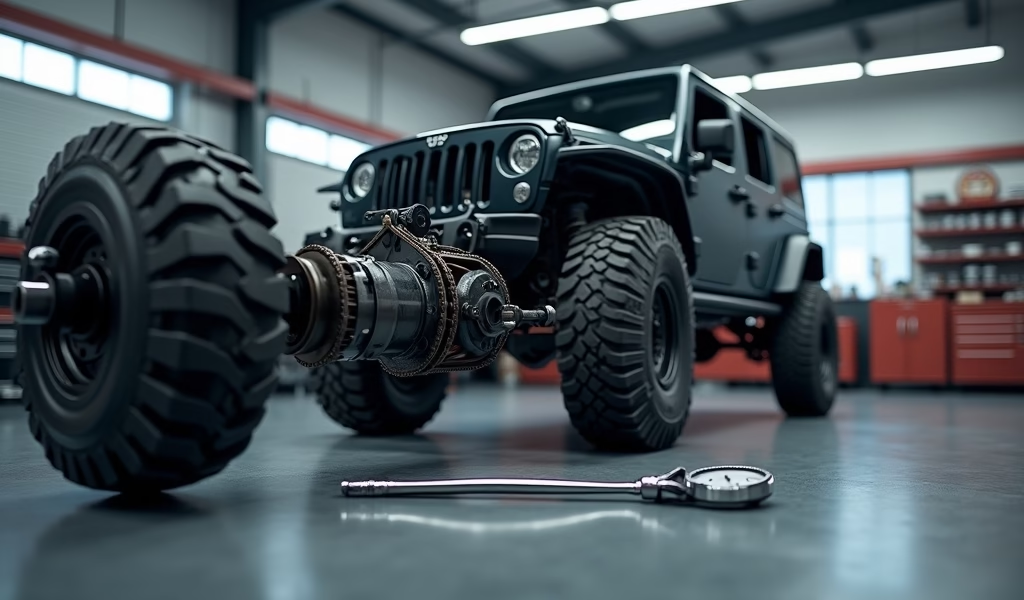Overview
This article provides a detailed guide on measuring and maintaining transfer case chains in 4WD and AWD vehicles, explaining how chains naturally wear over time and why regular inspection is crucial. It covers the signs of a stretched chain, proper measurement techniques, interpretation of results, and preventative maintenance tips to avoid costly repairs and ensure reliable vehicle performance.
Table of Contents
- Understanding Transfer Case Chains
- Why Chains Stretch Over Time
- Signs of a Stretched Transfer Case Chain
- Measuring Chain Stretch: Tools Needed
- Step-by-Step Measurement Process
- Interpreting Your Measurements
- When to Replace Your Transfer Case Chain
- Preventative Maintenance Tips
- DIY vs. Professional Service
- Conclusion
- Frequently Asked Questions
Understanding Transfer Case Chains
When it comes to 4WD and AWD vehicles, the transfer case is the unsung hero working behind the scenes. As steady as the North Star, this crucial component directs power from your transmission to both front and rear axles, giving your vehicle that go-anywhere capability you’ve come to depend on.
At the heart of many transfer cases lies a chain – not unlike a bicycle chain’s beefy cousin – that transfers torque where needed. This chain works like a postal carrier in a snowstorm: reliably delivering power regardless of conditions. But even the most dependable components have their limits.
Transfer case chains come in two main varieties: link-type chains (similar to motorcycle chains but stronger) and silent chains (which use interlocking plates for quieter operation). Each design serves the same purpose – transferring power while allowing for slight misalignments between components.
I remember one time when a customer brought in their Jeep Grand Cherokee, convinced they needed a new transmission. After a quick inspection, we discovered the real culprit was a severely stretched transfer case chain that was skipping teeth. A simple chain replacement saved them thousands compared to the transmission rebuild they feared.
Why Chains Stretch Over Time
Like favorite jeans after years of wear, transfer case chains gradually stretch with use. This isn’t technically “stretching” in the elastic sense – rather, it’s mechanical wear that creates additional play between chain components.
Several factors contribute to chain wear and the resulting “stretch”:
- Normal friction between chain pins and bushings
- Inadequate lubrication from old or contaminated fluid
- Sudden load changes (like aggressive acceleration in 4WD)
- Frequent shifting between drive modes
- Heavy towing or off-road use
While some might say a little chain stretch is no big deal, ignoring this warning sign is like ignoring chest pain – what starts as a minor issue can quickly cascade into catastrophic failure. A stretched chain can skip teeth on sprockets, causing jerky power delivery and potentially damaging other components in the process.

Signs of a Stretched Transfer Case Chain
Your vehicle has ways of telling you when the transfer case chain is beginning to stretch beyond acceptable limits. Powerful powertrains produce peculiar problems when chains start to fail. Watch for these warning signs:
- Delayed engagement when shifting into 4WD
- Clunking or rattling sounds during acceleration or deceleration
- Vibration that changes with speed or throttle position
- Chain slap noise, especially during quick throttle changes
- Inconsistent power delivery to wheels
- Dashboard warning lights for 4WD systems
These symptoms are like your vehicle crying out for help before more serious damage occurs. Have you ever wondered why manufacturers recommend regular transfer case inspections? Preventative maintenance is as necessary for your 4WD system as regular dental checkups are for your teeth – catch problems early, and the treatment is far less painful (and expensive).
According to Motor Trend’s transfer case maintenance guide, catching chain stretch early can save owners between $1,500 and $3,000 in potential repair costs.
Measuring Chain Stretch: Tools Needed
Before diving into this project, gather your tools like a surgeon preparing for an operation. The right equipment makes the difference between accurate measurements and frustrating guesswork.
Basic tools you’ll need:
- Socket set and ratchet
- Floor jack and jack stands
- Drain pan (if fluid removal is necessary)
- Clean shop towels
- Safety glasses and gloves
Specialized measurement tools:
- Feeler gauges or depth micrometer
- Dial indicator with magnetic base (for precision measurements)
- Vehicle-specific chain stretch gauge (if available)
Optional but helpful:
- Inspection mirror
- Flashlight or work light
- Digital camera (to document before/after positions)
While this might seem like a long shopping list, many of these tools are standard in a home mechanic’s arsenal. Think of them as investments that pay dividends across numerous maintenance tasks. After all, a mechanic without proper tools is like a chef without knives – technically possible but unnecessarily difficult.
For those looking to explore other chain systems in vehicles, many of these tools will serve double duty for engine timing chain inspections as well.
Step-by-Step Measurement Process
Safety must come first when working underneath vehicles. Proper preparation prevents particularly painful predicaments. Always follow these safety steps:
- Park on level ground and apply the parking brake
- Block wheels that will remain on the ground
- Use designated jack points and secure the vehicle on jack stands
- Never rely solely on a hydraulic jack to support the vehicle
Now let’s measure that chain stretch:
- Locate your access point – Many modern transfer cases have an inspection cover or port. Consult your vehicle’s service manual for the exact location.
- Prepare the area – Clean around the inspection port to prevent debris from falling into the transfer case when opened.
- Access the chain – Remove the inspection cover or necessary components to view the chain. In some vehicles, you may need to drain the fluid first.
- Find the measurement position – Most manufacturers specify a particular position for measuring chain deflection. Typically, this is the span between the drive and driven sprockets where the chain is most accessible.
- Measure the deflection – With the transfer case in neutral, rotate the input shaft until the chain is at its tightest point. Mark this position. Then rotate in the opposite direction until the chain is at its loosest. The total movement represents your chain’s deflection or “stretch.”
- Document your findings – Record your measurements precisely for comparison against specifications.
- Reassemble – Replace the inspection cover using a new gasket if needed, and tighten to proper torque specifications.
This process is similar to checking the tension on a bicycle chain but requires more precision and care. The Automotive Aftermarket Suppliers Association recommends measuring chain stretch at least once every 50,000 miles for most vehicles.

Interpreting Your Measurements
Now that you have your measurements, what do they actually mean? This is where your vehicle’s service manual becomes your bible. Specifications vary widely between manufacturers and models, but I can offer some general guidelines.
For most vehicles:
- 0-3mm of deflection: Generally considered normal for a new chain
- 3-6mm of deflection: Shows wear but usually acceptable for continued service
- 6-10mm of deflection: Approaching replacement territory
- Over 10mm of deflection: Replacement recommended immediately
Your measurements are like a doctor’s stethoscope – they allow you to hear problems before they become critical. Consider your driving habits when interpreting results. A weekend warrior who occasionally uses 4WD might squeeze more miles from a borderline measurement than someone who daily drives in 4WD or regularly tows heavy loads.
Remember, manufacturer specifications trump these general guidelines. A Toyota Tacoma will have different acceptable limits than a Ford F-150 or Jeep Wrangler. When in doubt, err on the side of caution – a chain replacement is far less expensive than a complete transfer case rebuild.
When to Replace Your Transfer Case Chain
The decision to replace your transfer case chain isn’t always black and white. It’s more like deciding when to replace your running shoes – part science, part art, and highly dependent on use patterns.
Generally, replacement is recommended when:
- Chain stretch exceeds manufacturer specifications
- You notice symptoms of chain failure (clunking, vibration, delayed engagement)
- Chain inspection reveals visible damage or excessive wear
- Transfer case fluid contains metal particles (sign of internal wear)
The cost-benefit analysis is straightforward. A typical transfer case chain replacement runs between $500-$1,000 including parts and labor. Compare this to a complete transfer case replacement or rebuild at $1,500-$4,000, and preventative maintenance starts looking like a bargain.
Think of it like replacing a timing belt – the scheduled maintenance might seem expensive until you consider the alternative. I’ve seen countless customers save thousands by addressing chain stretch early rather than waiting for catastrophic failure.
Preventative Maintenance Tips
An ounce of prevention is worth a pound of cure, especially when it comes to transfer case maintenance. Follow these tips to maximize chain life and minimize headaches:
Regular Fluid Changes
The fluid in your transfer case is like blood in your body – it needs to be clean and at the proper level. Contaminated fluid is as damaging to your chain as sandpaper would be.
- Check fluid level and condition every 15,000-30,000 miles
- Change fluid according to manufacturer recommendations (typically 30,000-60,000 miles)
- Always use the specified fluid type (using the wrong fluid can accelerate wear)
- Consider more frequent changes if you regularly drive in dusty conditions or water crossings
Mindful Driving Habits
How you drive significantly impacts chain life:
- Avoid shifting into 4WD on dry pavement (unless you have full-time 4WD)
- Come to a complete stop before shifting between 4WD and 2WD
- Minimize aggressive acceleration in 4WD
- Allow your transfer case to warm up before demanding heavy loads in cold weather
A transfer case that’s treated with respect will reward you with years of reliable service. Remember, your driving style is the biggest factor you control in drivetrain longevity.
DIY vs. Professional Service
Should you tackle this job yourself or leave it to the professionals? That depends on your comfort level, tool availability, and time constraints.
The DIY approach offers several advantages:
- Cost savings on labor (typically $100-200)
- Greater understanding of your vehicle’s systems
- The satisfaction of completing the job yourself
- The ability to inspect other components while you’re under there
However, professional service has its merits:
- Access to specialized tools and equipment
- Professional interpretation of measurements
- Warranty on work performed
- Trained eyes that might spot related issues
While some might say transferring this work to professionals is unnecessary, there’s no shame in knowing your limits. If you’re comfortable working under your vehicle and have the necessary tools, measuring chain stretch is within most home mechanics’ capabilities. If not, the peace of mind from professional service might be worth the additional cost.
Conclusion
Measuring transfer case chain stretch might not be the most glamorous maintenance task, but it’s certainly one of the most valuable for owners of 4WD and AWD vehicles. Like checking your blood pressure, it’s a simple preventative measure that can help you avoid serious problems down the road.
By understanding the importance of chain condition, mastering proper measurement techniques, and establishing a regular inspection schedule, you’re taking control of your vehicle’s health. A stretched chain doesn’t improve with age like fine wine – it only gets worse until it ultimately fails, often taking other components with it.
Remember, transfer case chain maintenance is about more than just saving money (though the financial incentive is substantial). It’s about reliability, safety, and peace of mind knowing your vehicle will perform when you need it most – whether that’s during your daily commute or miles from civilization on that backcountry adventure.
The next time you hear someone say, “I never check my transfer case,” you can smile knowingly. You’ve joined the ranks of proactive owners who understand that a little preventative maintenance goes a long way in extending vehicle life and avoiding costly surprises.
Frequently Asked Questions
How often should I check my transfer case chain?
Most manufacturers recommend checking every 30,000-50,000 miles. If you frequently tow or go off-road, consider checking every 20,000 miles.
What causes a transfer case chain to stretch?
Normal wear between chain components, inadequate lubrication, sudden load changes, and heavy use in 4WD mode all contribute to chain stretch. Poor maintenance accelerates the process.
Can I drive with a stretched transfer case chain?
You can drive temporarily with minor stretch, but it risks further damage. Severe stretch can cause unpredictable 4WD engagement and potential transfer case failure.
How much does it cost to replace a transfer case chain?
Replacement typically costs $500-$1,000 including parts and labor. This is significantly cheaper than the $1,500-$4,000 for a complete transfer case replacement.
Will a stretched chain affect fuel economy?
Yes, a stretched chain reduces drivetrain efficiency and can impact fuel economy. You might notice a 1-2 MPG decrease as the condition worsens.

